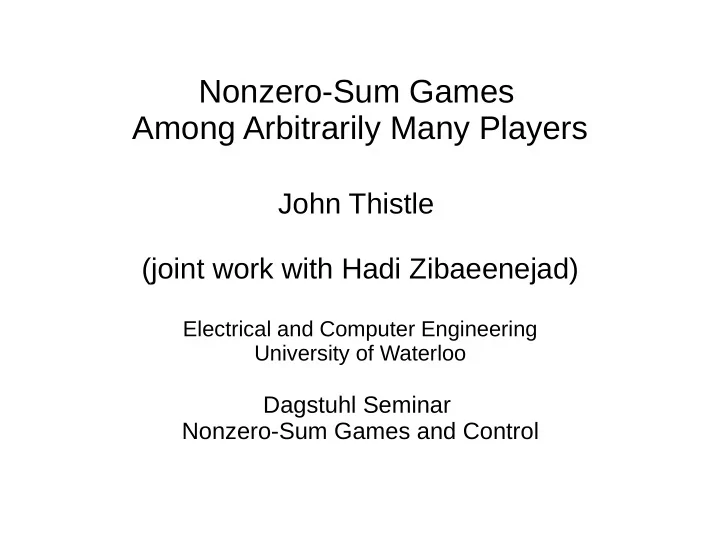

Nonzero-Sum Games Among Arbitrarily Many Players John Thistle (joint work with Hadi Zibaeenejad) Electrical and Computer Engineering University of Waterloo Dagstuhl Seminar Nonzero-Sum Games and Control
For details: M.H. Zibaeenejad and J.G. Thistle, 'Weak invariant simulation and its application to analysis of parameterized networks,' IEEE Transactions on Automatic Control 59 (8), August 2014; pp. 2024-2037. M.Hadi Zibaeenejad and John G. Thistle, 'Dependency graph: an algorithm for analysis of generalized parameterized networks,' 2015 American Control Conference. (To appear.)
Motivation: – Computer/communication networks, transportation networks, manufacturing systems, … modelled as interacting, similar, finite state-machines. – Number of components may be large, variable or unknown. – How much synthesis/analysis can be done without fixing number? – e.g., reachability of deadlock
“Parameterized systems” – Verification generally undecidable Apt/Kozen '86 – Some decidability results for ring networks: Emerson et al '02,'03 – unidirectional unary token-passing – or, DP chopstick-style tokens – logics can't express deadlock. – Can we check reachability of deadlock under less restrictive assumptions?
Idea of approach – Restrict flow of control & information less severely … by formulating simulation relations. – If one process simulates another, … it does not “block” their shared events … yet their interaction can be complex.
Invariant simulation A simulation relation … that is preserved whenever both processes execute the same events:
Invariant Simulation (ctd) Such relations need not be reflexive (!):
Weak Invariant Simulation – Weak version, in usual sense: The larger the subalphabet, the stronger the simulation requirement, the weaker the invariance requirement.
Weak Invariant Simulation and Synchronous Products – A weak invariant simulation with respect to all shared events is preserved under synchronization … … if the event subalphabet is larger, the simulation need not be preserved.
Ring networks Assume all component processes isomorphic, … and based on same state set.
Ring networks (ctd) – Impose a direction of “dependency”: – Assume that each process is strongly connected ... … and that each shared event is possible only at a single state in the upstream neighbour …
Simulation relations Assume a WIS of each process by its upstream neighbour w.r.t. their set of shared events … and another w.r.t. all the shared events of the upstream neighbour. – The simulation requirements of the latter assumption are strong – we'll weaken it when we look at other topologies. – But note that the invariance requirement is weak. – Nevertheless, one can show that at least one such relation holds at every moment.
Lemma: At no point in the network's evolution is any shared event permanently prevented by the upstream neighbour. Define a “dependency relation”: For any two neighbours, find the reachable component of their synchronous product … after deleting from the upstream neighbour any transitions shared with its upstream neighbour … … and find all states where the only event defined is a shared event of the downstream neighbour with its other neighbour. – “dependent on downstream processes”
T h e o r e m : The reachable deadlocked states of all size instances of the network are exactly those corresponding to cycles in this dependency relation. – So these states can be encoded as the words of a regular language.
Branching topology Specify a network graph: Nodes = distinguished processes Edges = linear networks of arbitrarily many isomorphic processes
Branching topology (ctd) – No leaves – Unique node with in-degree > 1: input process – has outdegree 1 – Others are output processes – Assume that every isolated cycle satisfies same assumptions as ring network, except “strong” one.
Input process assumption Assume that there is a weak invariant simulation by the input process of its downstream neighbour … … with respect to all shared events of the input process … which contains all state pairs in the synchronous product of the input process and its downstream neighbour. Also, events shared with different neighbours can't occur in same state of input process.
Output process assumption Assume that there is a weak invariant simulation by any output process of each of its downstream neighbours … … with respect to the set of all shared events of the output process that are not shared with its upstream neighbour.
Dependency graph – Considering isolated cycles, define a dependency relation similar to that of ring networks. – Use it to construct a dependency graph. – The circular waits of ring networks generalize to full , consistent subgraphs of this dependency graph. Full: accounts for all branches Consistent: contains at most one state of any distinguished process
Theorem: A partial deadlock represented by a full, consistent subgraph is reachable if and only if the subgraph is o u t p u t - r e a c h a b l e . Output-reachable: Any state of an output process is reachable within that process by means of local events and events shared with the upstream neighbour.
The set of network states represented by full, consistent, output-reachable subgraphs can be recognized by a finite automaton.
Conclusion – Used weak invariant simulation to restrict flow of control – Allowed characterization of reachable deadlock states as regular languages – First step toward deadlock-free synthesis?
Recommend
More recommend